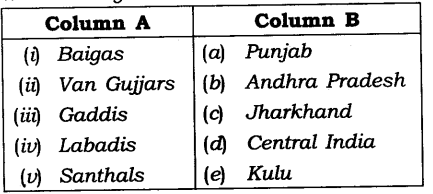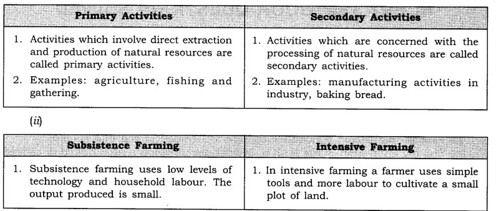EVENTS CONVENT HIGH SCHOOL
08/11/2021 CLASS- 8 SESSION 2021-22
SUBJECT : SOCIAL SCIENCE(HISTORY)
CHAPTER-4
TRIBALS DIKUS AND THE VISION OF A GOLDEN AGE
______________________________________
Question 1.
Choose the correct option:
(i) The Khonds belonged to
(a) Gujarat
(b) Jharkhand
(c) Orissa
(d) Punjab
(ii) British officials saw these settled tribal groups as more civilised than hunter-gatherers
(a) Gortds
(b) Sahthals
(c) Khonds
(d) Both (a) and (b)
(iii) Vaishnav preachers were the worshippers of
(a) Shiva
(b) Durga
(c) Krishna
(d) Vishnu
(iv) Kusum and Palash flowers were used to
(a) prepare medicines
(b) make garlands
(c) color clothes and leather
(d) prepare hair oil
(v) The Gaddis of Kulu was
(a) shepherds
(b) cattle herders
(c) fruit gatherers
(d) hunters
Answer:
(i) (c), (ii) (d), (iii) (d), (iv) (c),(v) (a).
Question 2.
Fill in the blanks with appropriate words to complete each sentence.
- The lives of shifting cultivators depended on free movement within …………….
- The …………… were not ready to work as laborers.
- The British wanted tribal groups to …………. and become …………… cultivators.
- The British declare that forests were …………… property.
- Birsa was born in a family of ………….. a tribal group that lived in …………………
- The Santhals of Hazaribagh reared
Answer:
- forests
- Baigas
- settle down, peasant
- state
- Mundas, Chottanagpur
- cocoons
Question 3.
State whether each of the following statements is True or False.
- The traders and moneylenders never deceived the tribal people.
- The silk growers earned huge amount of wealth and therefore enjoyed a happy life.
- Many tribal groups did not like the colonial forest laws and therefore revolted.
- The jhum cultivators in north-east India stopped their traditional practice.
- The tribal Chiefs lost their authority under the British rule.
Answer:
- False
- False
- True
- False
- True
Question 4.
Match the items given in Column A correctly with those given in Column B.
Answer:
(i) (d)
(ii) (a)
(iii) (e)
(iv) (b)
(v) (c)
Class 8 History Chapter 4 Tribals, Dikus and the Vision of a Golden Age Very Short Answer Questions
Question 1.
Mention different types of activities of the tribal people.
Answer:
- Some practiced jhum cultivation,
- Some were hunter-gatherers.
- Some herded animals.
- Some took to settled cultivation.
Question 2.
Why did the British want tribal groups to settle down and become peasant cultivators?
Answer:
It was because settled peasants were easier to control and administer than people who were always on the move.
Question 3.
Why did the British introduce land settlements?
Answer:
They did so in order to get a regular revenue source for the state.
Question 4.
Why were some forests classified as Reserved Forests?
Answer:
These forests produced timber which the British wanted.
Question 5.
What problem did the British face after they stopped the tribal people from living inside forests?
Answer:
They faced the problem of shortage of labour.
Question 6.
Why did the Forest Department establish forest villages?
Answer:
It did so in order to ensure a regular supply of cheap labour.
Question 7.
How did the tribal groups view the market and the traders?
Answer:
They viewed them as their main enemies.
Question 8.
Who was Birsa?
Answer:
Birsa belonged to a family of Mundas, a tribal group that lived in Chottanagpur.
Question 9.
What did people say about him?
Answer:
People said that he had miraculous powers. He could cure all diseases and multiply grain.
Question 10.
What problems did Birsa set out to resolve?
Answer:
- The familiar ways of tribals seemed to be disappearing.
- Their livelihoods were under threat.
- The religion appeared to be in danger. Birsa set out to resolve these problems.
Class 8 History Chapter 4 Tribals, Dikus and the Vision of a Golden Age Short Answer Type Questions
Question 1.
What were the main activities of the Khonds living in the forests of Orissa?
Answer:
The Khonds were basically hunter-gatherers. They regularly went out on collective hunts and then divided the meat amongst themselves. They ate fruits and roots collected from the forest and cooked food with the oil they extracted from the seeds of the sal and mahua. They used many forest shrubs and herbs for medicinal purposes and sold forest produce in the local markets. All their activities were based on forests.
Question 2.
How did traders and moneylenders exploit the tribal people?
Or
How were traders and moneylenders cause of the tribals’ misery? [V. Imp.]
Answer:
Tribal groups often needed to buy and sell in order to be able to get the goods that were not produced within the locality. This led to their dependence on traders and moneylenders. Traders came around with things for sale. They sold the goods at high prices.
Moneylenders used to give loans with which the tribals met their cash needs, adding to what they earned. But the interest charged on the loans was very high. Thus, both traders and moneylenders always exploited tribal people. It is therefore the tribals- saw them as evil outsiders and the cause of their misery.
Question 3.
How did the British officials view settled tribal groups and those who moved about from place to place?
Answer:
The British officials saw settled tribal groups such as the Gonds and Santhals as more civilised than hunter-gatherers or shifting cultivators. These tribal groups lived in the forests and kept on moving. They did not have a fixed home. The British considered them wild and savage and therefore they needed to be settled and civilised.
Question 4.
Describe land settlements introduced by the British.
Answer:
The British introduced land settlements to ensure a regular revenue source for the state. Under these settlements:
- the British measured the land, defined the rights of each individual to that land, and fixed the revenue demand for the state.
- some peasants were declared landowners, other tenants. The tenants were to pay rent to the landowner who in turn paid revenue to the state.
Question 5.
Why was the British effort to settle jhum cultivators not very successful?
Answer:
(a) It is usually difficult to carry on settled plough cultivation in areas where water is scarce and the soil is dry.
(b) Jhum cultivators who took to plough cultivation often suffered since their fields did not preclude good yields. Hence, the jhum cultivators in north-east India insisted on continuing with their traditional practice.
(c) The British faced widespread protests. Therefore, they allowed them to carry on shifting cultivation in some parts of the forest.



